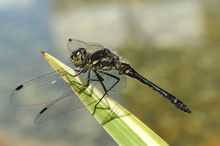Black Darter
| Black Darter | |
|---|---|
 | |
| Male S. danae | |
.jpg) | |
| Female S. danae | |
| Conservation status | |
| Not evaluated (IUCN 3.1) | |
| Scientific classification | |
| Kingdom: | Animalia |
| Phylum: | Arthropoda |
| Class: | Insecta |
| Order: | Odonata |
| Suborder: | Anisoptera |
| Family: | Libellulidae |
| Genus: | Sympetrum |
| Species: | S. danae |
| Binomial name | |
| Sympetrum danae (Sulzer, 1776) | |
The Black Darter or Black Meadowhawk (Sympetrum danae) is a dragonfly found in northern Europe, Asia, and North America. At about 30 mm (1.2 in) long, it is Britain's smallest resident dragonfly. It is a very active late summer insect typical of heathland and moorland bog pools.
Members of the genus Sympetrum are known as darters in the UK and as meadowhawks in the US and Canada.
Identification
Both sexes have black legs and pterostigmata and a very broad base to the hind wing. The thorax has yellow sides separated by a bold black panel in which are three yellow spots, resembling a Highland Darter (Sympetrum nigrescens).
The male has a mainly black thorax and abdomen. The abdomen has small yellow marks on the side, that darken with age. The wings are clear.
The female has black legs and brown eyes. The abdomen is mainly yellow, becoming browner with age. It has small yellow patches at the wing bases.
Breeding
This Darter is restricted to acidic shallow pools, lake margins and ditches in lowland heath and moorland bogs, usually with bog-mosses and rushes.
Eggs are laid in flight by dipping the tip of the abdomen into the water. The eggs hatch the following spring and the larvae develop very rapidly, emerging after as little as two months.
Behaviour
Males frequently bask in the sun, on open ground. The flight action is rather skittish resembling the Ruddy Darter. Males are not territorial, but actively seek out females. This species is the smallest of Britain’s dragonflies. Although not as colourful as some other dragonflies it is a lovely dragonfly to watch. They often perch on a sunny spot on the ground. Their flight is a little skittish, and often flies away as you approach, but sometimes it is in a 'friendly mood' and lets you get very close. Sometimes they may even land on an observer’s hand.
Population and conservation
In the British Isles, this dragonfly is very locally distributed in the lowlands, but more widespread in the north-west and Ireland. It is often very locally abundant and maybe this triggers dispersal. Records from the south coast suggest that immigration from the continent does occur. Its main threats, however, are development, drainage, agriculture, and peat extraction.
References
- Black Meadowhawk, NJodes
- "Sympetrum danae". British Dragonfly Society. Retrieved 18 August 2010.
External links
 Media related to Sympetrum danae at Wikimedia Commons
Media related to Sympetrum danae at Wikimedia Commons Data related to Sympetrum danae at Wikispecies
Data related to Sympetrum danae at Wikispecies- Black Meadowhawk, Talk about Wildlife
- Black Meadowhawk, Insects of Alberta
- Black Meadowhawk, NaturePhoto-CZ
- Black Meadowhawk, Iowa Odonata Survey